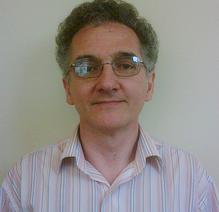 |
Esteban Broitman, Ph.D., Linköping University, Sweden Esteban Broitman received his Ph.D. degree in Physics from the University of Buenos Aires, Argentina, in 1997. He has been doing research and teaching at the University of Buenos Aires (Argentina), The College of William and Mary (USA), and Carnegie Mellon University (USA). He is currently a Professor at Linköping University (Sweden). His research activities focus on the nanomechanical and nanotribological properties of hard coatings of carbon-based coatings, nanocomposites, and soft materials like soft metals and polymers. |
Speech Title 1: Nanomechanical Properties of Polymeric Materials by Nanoindentation Techniques: an Overview Abstract: Nowadays, there is permanent increase in the use of polymers to substitute metals and ceramics. Advantages like excellent mechanical properties with low density, resistance to solvents, and being able to be easily designed in complicated configurations make polymer the modern material to be selected by the industry. During the last decade, polymers have been also developed in applications at micron- and even nano-scale. There are many devices such as polymer light-emitting devices, polymer nanofibers, and biomaterial applications. For this kind of micro- and nano-structures, conventional mechanical characterization techniques like tensile, compression and bending tests are inapplicable due to the size of the samples. Nanoindentation technique, widely used to characterize the mechanical properties of hard materials, has started to be used also to characterize polymers. In this talk, the application of indentation techniques to measure the hardness, elastic modulus, and creep of polymers is discussed. A comparison between nanoindentation results and macroscopic properties is offered. The recent literature on polymer nanocomposites will be also reviewed. Finally, indentation size effects are also critically examined. Challenges and future perspectives in the application of nanoindentation to characterize mechanical properties of polymer materials are suggested. | |
Speech Title 2: Basic Guidelines for Structuring a Scientific Paper Abstract: According to recent estimations, more than 3 million research articles will be submitted during 2015 to scientific journals, of which only less than one third will end up being published in a peer-reviewed journal. There are many reasons for a manuscript to be rejected, like choosing a bad journal, having ethical issues, organizing the manuscript in a wrong way, writing too-many language mistakes, etc. This talk is aimed to provide to students and early-stage researchers with a brief introduction to one aspect of the complex matter of publishing: the organization of the paper. Scientists usually read scientific literature for information and not for entertainment. Thus, the manuscript has to be well organized in order to give the scientific information clearly, understandably, logically, and concisely. In this talk I will show some basic guidelines for writing a scientific paper reporting experimental work. I will discuss in detail the structural parts of a typical scientific paper including title, abstract, body, discussion, conclusions, and references. Tips on how to present the manuscript and have a better chance to be published will be given. | |
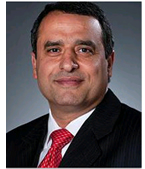 |
Alaa S. Abd-El-Aziz, University of Prince Edward Island (UPEI), Canada Dr. Alaa S. Abd-El-Aziz assumed his responsibilities as the sixth president and vice-chancellor of the University of Prince Edward Island on July 1, 2011. Since that time he has championed a highly collaborative strategic planning process designed to define and advance the strategic direction of UPEI and support its academic mission—teaching, research, and service. Throughout his administrative career, Dr. Abd-El-Aziz has remained actively involved in chemistry, making significant contributions to research and teaching in his field of inorganic and organometallic polymers and materials. He has authored over 150 peer-reviewed articles in prestigious academic journals, one book, and ten book chapters; and edited 14 books. He is the editor of the Journal of Inorganic and Organometallic Polymers and Materials and is on the editorial board of six other journals related to his field of expertise. |
Speech Title: From Organoiron to Macromolecules: a Facile Approach to Diverse Functional Materials | |
| Abstract: Nowadays, there is permanent increase in the use of polymers to substitute metals and ceramics. Advantages like excellent mechanical properties with low density, resistance to solvents, and being able to be easily designed in complicated configurations make polymer the modern material to be selected by the industry. During the last decade, polymers have been also developed in applications at micron- and even nano-scale. There are many devices such as polymer light-emitting devices, polymer nanofibers, and biomaterial applications. For this kind of micro- and nano-structures, conventional mechanical characterization techniques like tensile, compression and bending tests are inapplicable due to the size of the samples. Nanoindentation technique, widely used to characterize the mechanical properties of hard materials, has started to be used also to characterize polymers. In this talk, the application of indentation techniques to measure the hardness, elastic modulus, and creep of polymers is discussed. A comparison between nanoindentation results and macroscopic properties is offered. The recent literature on polymer nanocomposites will be also reviewed. Finally, indentation size effects are also critically examined. Challenges and future perspectives in the application of nanoindentation to characterize mechanical properties of polymer materials are suggested. |
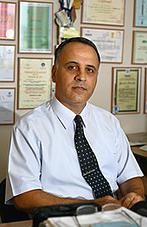 |
Dumitru Nedelcu, Ph.D., Gheorghe Asachi Technical University of Iasi, Romania Dr. Dumitru Nedelcu is Professor and PhD supervisor at the “Gheorghe Asachi” Technical University of Iasi, Romania, Department of Machine Manufacturing Technology. He graduated the Faculty of Machine Manufacturing from the University above mentioned and Faculty of Economics and Business Administration of “Al.I. Cuza” University of Iasi. He is involved in Fine Mechanics & Nano-Technology and Technologies for Obtaining and Processing of Composite Materials courses and research activities. He received a Tempus and Romanian Government Scholarships at Escuela Tecnica Superior de Ingenieros Industriales, Politecnica University of Madrid, Spain. He is manager of Laboratory of Fine Mechanics and Nanotechnology certified according to the ISO 2008 Quality Management System and recertified by ESYD Greece. More... |
Speech Title: Layered Composite Materials and Reinforced with Si-C Particles Abstract:Layered composite materials significantly improved the mechanical process of fracturing, which means better fracture strength, while preserving surface properties such as hardness, resistance to wear and resistance to high temperatures. The properties are significantly influenced by the interphase mass transfer at the surface matrix-fiber reinforcement. Was developed a mathematical model to determine the molar flux at the interface in stationary and in a nonstationary regime. From this point of view the main technological parameters took into account were: hydraulic pressure, reinforced material, alloy type, fiber diameter, mass ratio between the reinforcement and the composite masses and mould preheating temperature. Was studied the material structure, matrix and fiber element distribution, metallic matrix element distribution and matrix and fiber element content variation. The reinforcement material, mass ratio and fiber diameter have significant influences on the fracture strength. The technologies of producing metallic matrix composites and SiC reinforced particles are determined by the gas/liquid and liquid/solid particle transfer. Theoretically, the values of the technological parameters necessary for the homogenous distribution and the incorporation of the reinforcement particles are presented. The investigation and the characterization of the achieved composites was made from the standpoint of mechanic properties (tear resilience, hardness), chemical-structural properties (scanning electron micrograph (SEM) and energy dispersive X-ray spectroscopy (EDX)), and tribological properties (linear wear intensity, friction). Furthermore, the density difference and the size of the reinforcement particles influence the critical velocity of the SiC particles at the gas/liquid interface. | |
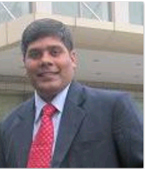 |
Ajay Kumar Mishra, University of Johannesburg, South Africa Prof. Ajay Kumar Mishra is currently working as Professor at Nanotechnology and Water Sustainability Unit, College of Science, Engineering and Technology, University of South Africa, Florida Science Campus, 1709 Rooderport, Johannesburg, South Africa. He is also working as “Adjunct Professor” at Jiangsu University, China. Prof. Mishra has pursued PhD in Chemistry from Department of Chemistry, University of Delhi, Delhi, India. In 2006, he moved to the University of Free State, South Africa for Postdoctoral studies in the area of composites/nanocomposites. Later in 2009 Prof. Mishra has joined Department of Applied Chemistry as Senior Lecturer where he was promoted to Associate Professor in 2011. Prof. Mishra is currently group leader of the research area for the composites/nanocomposites,More... |
Speech Title: Current and Futuristic Smart Materials for Water Remediation Abstract:Recently, the world faces a global challenge on clean water scarcity. Clean water are decreasing due to pollution, population growth, drought and competing demand from a variety of users. Several sources of water pollutions are well documented which either is created by industry or other sources including man-made. These pollution casing elements are known as pollutants which exist in different form. Some example of such pollutants can be in the form of organic, inorganic and microbial. Heavy metals in the form of inorganic pollutants have been a serious concern due to their growing discharge, toxicity and other adverse effect. Treatment of aqueous waste containing soluble heavy metals requires concentration of the metal in a small volume. Several treatment processes have been developed to remove both dissolved and suspended heavy metal ions from waste water. Varieties of smart materials have been applied for the removal of heavy metals from waste water. My talk will focus on the current status and prospects of such smart materials for the water remediation. | |
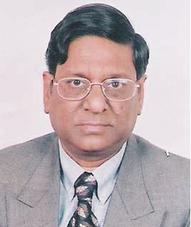 |
Dr. Ram K. Agarwal, Department of Chemistry, Lajpat Rai Postrgraduate College, SAHIBABAD (GHAZIABAD)-201005, INDIA |
Speech Title: Designing of Targeting Multifunctional Thiosemicarbazones Derived from Heterocyclic Compounds and Their Metal Coordination Compounds in Biological and Medicinal Inorganic Chemistry Abstract:Medicinal inorganic chemistry is a multidisciplinary field combining elements of chemistry, pharmacology and toxicology, biochemistry, biophysics and medicinal chemistry.This branch of Chemistry has growing significance in both therapeutic and diagnostic medicine. The history and basic concepts of medicinal inorganic chemistry has been recently reviewed. The unique properties of metal complexes may offer advantages in the discovery and development of new drugs. The development of modern medicinal inorganic chemistry stimulated by the discovery of cisplatin has been facilitated by the inorganic chemists’ extensive knowledge of the coordination properties of metal ions. A broad array of biological and medicinal applications of metal complexes has been investigated and many authors summarize advances in these fields.More... | |
|
Professor N.M. RAVINDRA (RAVI), Director, Interdisciplinary Program in Materials Science and Engineering,
New Jersey Institute of Technology, Newark, NJ 07102 N.M. Ravindra (Ravi) is Professor of Physics & Director, Interdisciplinary Program in Materials Science and Engineering, New Jersey Institute of Technology. He was the Chair of the Physics Department & Director, Interdisciplinary Program in Materials Science and Engineering at NJIT from 2009 to 2013. Ravi is the Editor-in-Chief of Emerging Materials Research. He is Series Editor of Emerging Materials: Processing, Performance and Applications, Momentum Press. He has been a frequent Guest Editor of JEM, the Journal of Electronic Materials;JOM. He serves on the editorial board of Microwave Processing More... | |
Speech Title: Engineered Composite Materials – Applications to Energy & Sports Abstract:Composite materials exhibit a unique combination of a variety of mechanical properties. By engineering these properties, composite materials can be utilized in several applications including energy, sports etc. An overview of the utility of composite materials in energy and sports related industry is presented. Case studies of the transition of fundamental research in composite materials to manufacturing of energy and sports related products are described. | |
 |
Prof. Dr. Francoise Monnoyeur, University of Linköping (Sweden) Francoise Monnoyeur received her Ph.D. degree in Philosophy from Poitiers University, France, in 1992. She has been doing research and teaching at the University of Linköping (Sweden), The College of William and Mary (USA), and The Academy of Sciences, Paris, (France). Her main publications focus the problem of Infinity, Life, and Matter. She is also concerned about ethical issues in science and engineering. |
Speech Title: Ethics Issues in Scientific Publishing Abstract:Nowadays, publishing scientific papers in per-reviewed journals of high impact-factor is vital for researchers’ success because, without enough publications, the possibilities to get funded and/or to get promoted at their universities or institutes are very slim. The aim of this talk is to discuss some ethical issues encountered during publication of scientific articles. Specific questions will be discussed: Who is considered an author? Can I publish the same data in different papers? What are the main publication rules and protocols followed in the West World? Is there an “occidental” ethics in publishing? This talk contributes to increase awareness of ethical matters relevant to scientific investigation and publication, facilitating new discussions among researchers and scientists. | |



